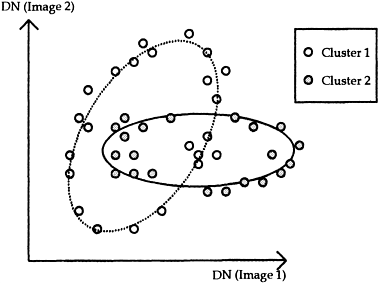306.
| [Cover] [Contents] [Index] |
Page 74
 |
|
with
 |
(2.17) |
These equations provide the basic idea for calculating the distance between a quadratic prototype and a pixel. However, to obtain robust clustering results, some other constraints may be added to the clustering process to avoid the trivial solution (such as all membership values being set equal to zero), and the parameters shown in Equation (2.14) are updated iteratively until the constraints have been satisfied. The idea of forming each cluster-dependent function is equivalent to interpolating a best-fit, hyper-quadric surface to the distribution of observations in a cluster (Krishnaparam et al., 1991, 1993).
An example using two shell clusters is shown in Figure 2.7. It is shown that nearly half of cluster 2 is surrounded by cluster 1, and there are also a small number of pixels belonging to cluster 1 within the cluster 2 shell. The traditional ‘compact cluster’ assumption is unable to deal with such a data distribution, but shell clustering provides a solution.
The concept of shell clustering has attracted considerable interest among researchers. The reduction of the computational demands and the development of procedures to overcome noise effects are the main issues that need

Figure 2.7 Two shell clusters in a two-dimensional space. Each shell is characterised by an equation similar to Equation (2.13). See text for further discussion.
| [Cover] [Contents] [Index] |
EAN: 2147483647
Pages: 354
- Preventing a Name Server from Querying a Particular Remote Name Server
- Preventing a Name Server from Responding to DNS Traffic from Certain Networks
- Configuring a DHCP Server to Update a BIND Name Server
- Signing Queries and Dynamic Updates with TSIG Programmatically
- Sending syslog Output to Another Host